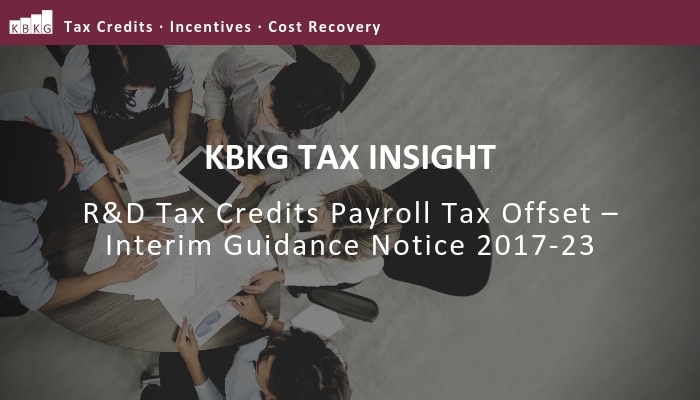The Treasury Department and Internal Revenue Service (IRS) released interim guidance surrounding the payroll tax credit election available to certain small businesses under Section 41(h) of the Internal Revenue Code (IRC). The addition of the payroll tax offset was introduced as part of the Protecting Americans from Tax Hikes (“PATH”) act of 2015.
Notice 2017-23 provides interim guidance regarding:
- The term “qualified small business”
- Determining gross receipts for purposes of §41(h)
- The time and manner of making the payroll credit election and claiming the credit
The term “qualified small business”
A qualified small business is a corporation, partnership, or individual with less than $5 million of gross receipts during the tax year AND the taxpayer did not have gross receipts for any tax year before the fifth tax year ending with the year of the claim. For example, taxpayers claiming the credit on their 2016 tax returns must have less than $5 million in gross receipts during 2016 and could not have had any gross receipts prior to 2012.
KBKG Insight: A taxpayer’s gross receipts prior to the year in which the election is made are not relevant. Thus, taxpayers that meet the five-year test and that have less than $5 million in gross receipts in the year of the election can have more than $5 million in gross receipts in the period(s) prior to the election.
Determining gross receipts for purposes of §41(h)
The term “gross receipts” means gross receipts as determined under § 448(c)(3) (without regard to § 448(c)(3)(A)) and § 1.448-1T(f)(2)(iii) and (iv) of the Income Tax Regulations. The definition of gross receipts under § 41(c)(7) and § 1.41-3(c) does not apply for purposes of § 41(h).
The time and manner of making the payroll credit election and claiming the credit
A qualified small business makes a payroll tax credit election by completing the appropriate portion of Form 6765, Credit for Increasing Research Activities and attaching the completed form to the qualified small business’s timely filed (including extensions) return for the taxable year to which the election applies.
The interim guidance states a small business may make the election on an amended return filed on or before December 31, 2017. To qualify for this extension, the business must either:
- indicate on the top of its Form 6765 reflecting the payroll tax credit election that the form is “FILED PURSUANT TO NOTICE 2017-23,” or
- attach a statement to its Form 6765 reflecting the payroll tax credit
Furthermore, the interim guidance provides special rules for controlled groups. Each member of a controlled group can separately make the payroll tax credit election. Regardless of whether each member in the controlled group makes the election, the $250,000 amount is allocated to each member of the controlled group in the same manner as the group’s research credit (i.e., in proportion to the qualified research expenses incurred per Reg. § 1.41-6T(c)).
Lastly, the interim guidance discusses the procedures for claiming the credit on the employment tax return.
A qualified small business that elects to claim the payroll tax credit and files quarterly employment tax returns, claims the payroll tax credit on its employment tax return for the first quarter that begins after it files its income tax return. For example, if a qualified small business files their 2016 income tax return on April 10, 2017, with a Form 6765 attached reflecting the payroll tax credit election, the qualified small business would claim the payroll tax credit on its Form 941, Employer’s Quarterly Federal Tax Return, for the third quarter of 2017. A qualified small business that files annual employment tax returns claims the payroll tax credit on its annual employment tax return that includes the first quarter beginning after the date on which the business files the income tax return reflecting the election.
A qualified small business claiming the payroll tax credit on its employment tax return must complete the new Form 8974, Qualified Small Business Payroll Tax Credit for Increasing Research Activities and attach the completed form to that employment tax return. The Form 8974 will serve as the “bridge” between employment tax forms and Form 6765.
The Treasury Department and the IRS request comments on the interim guidance described in this notice and other issues affecting payroll tax credit elections that may require additional guidance by July 17, 2017.
Author: Paul McVoy | Co-Author: Kevin Zolriasatain


